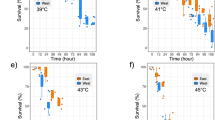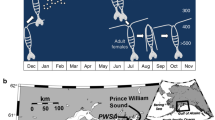Abstract
The intertidal mussel Mytilus californianus is subjected to thermal and oxygen cycles due to fluctuations of the tidal cycle. Mussels that reside in high-shore microenvironments experience extended periods of aerial-exposure and greater thermal challenges than low-shore populations. In this study, we investigated the combined effect of daily extended periods of aerial-exposure and midday thermal events on the physiology of mussels by monitoring transcriptome-wide gene expression in a simulated tidal environment. Mussels were acclimated to aerial-exposure for 20 h a day combined with a simulated midday solar heating event of + 8 °C. Results revealed that 11% of the transcriptome exhibited robust patterns of rhythmic gene expression. Two broad sets of genes were induced, including one that was upregulated during the daytime thermal stress period and another following the 4-h evening high-tide. The daytime thermal stress associated gene set was enriched for genes related to cellular regulatory pathways such as those that encode transcription factors while genes expressed following evening submergence varied in functional theme. Additionally, genes related to energy metabolism were also upregulated during warming periods of the tidal cycle. Comparing these data to published data from a previous tidal simulation study revealed that acclimation to daily heat stress yielded a muted transcriptional response to heat compared to an acute response observed in mussels maintained under isothermal conditions. These results indicate that M. californianus displays phenotypic plasticity with respect to transcriptomic expression and that this trait likely promotes homeostasis in the intertidal environment.





Similar content being viewed by others
Data availability
The datasets during and/or analyzed during the current study are available from the corresponding author on reasonable request.
References
Anderson P, Kedersha N (2006) RNA granules. J Cell Biol 172:803–808
Bayne BL, Bayne CJ, Carefoot TC, Thompson RJ (1976) The physiological ecology of Mytilus californianus Conrad. Oecologia 22:229–250
Broitman BR, Szathmary PL, Mislan KAS, Blanchette CA, Helmuth B (2009) Predator–prey interactions under climate change: the importance of habitat vs body temperature. Oikos 118:219–224
Buckley BA, Owen M-E, Hofmann GE (2001) Adjusting the thermostat: the threshold induction temperature for the heat-shock response in intertidal mussels (genus Mytilus) changes as a function of thermal history. J Exp Biol 204:3571–3579
Cohen DM, Wasserman JC, Gullans SR (1991) Immediate early gene and HSP70 expression in hyperosmotic stress in MDCK cells. Am J Physiol Physiol 261:C594–C601
Connor KM, Gracey AY (2011) Circadian cycles are the dominant transcriptional rhythm in the intertidal mussel Mytilus californianus. Proc Natl Acad Sci 108:16110–16115
Connor KM, Gracey AY (2012) High-resolution analysis of metabolic cycles in the intertidal mussel Mytilus californianus. Am J Physiol Integr Comp Physiol 302:R103–R111
Connor KM, Robles CD (2015) Within-site variation of growth rates and terminal sizes in Mytilus californianus along wave exposure and tidal gradients. Biol Bull 228:39–51
Connor KM, Sung A, Garcia NS, Gracey AY, German DP (2016) Modulation of digestive physiology and biochemistry in Mytilus californianus in response to feeding level acclimation and microhabitat. Biol Open 5:1200–1210
De Zwaan A (1977) Anaerobic energy metabolism in bivalve molluscs. Ocean Mar Biol Annu Rev 15:103–187
Denny MW, Dowd WW, Bilir L, Mach KJ (2011) Spreading the risk: small-scale body temperature variation among intertidal organisms and its implications for species persistence. J Exp Mar Biol Ecol 400:175–190
Dhar R, Sägesser R, Weikert C, Wagner A (2012) Yeast adapts to a changing stressful environment by evolving cross-protection and anticipatory gene regulation. Mol Biol Evol 30:573–588
Dragosits M, Mozhayskiy V, Quinones-Soto S, Park J, Tagkopoulos I (2013) Evolutionary potential, cross-stress behavior and the genetic basis of acquired stress resistance in Escherichia coli. Mol Syst Biol 9:643
Evans TG, Somero GN (2010) Phosphorylation events catalyzed by major cell signaling proteins differ in response to thermal and osmotic stress among native (Mytilus californianus and Mytilus trossulus) and invasive (Mytilus galloprovincialis) species of mussels. Physiol Biochem Zool 83:984–996
Fitzhenry T, Halpin PM, Helmuth B (2004) Testing the effects of wave exposure, site, and behavior on intertidal mussel body temperatures: applications and limits of temperature logger design. Mar Biol 145:339–349. https://doi.org/10.1007/s00227-004-1318-6
Gleason LU, Miller LP, Winnikoff JR, Somero GN, Yancey PH, Bratz D, Dowd WW (2017) Thermal history and gape of individual Mytilus californianus correlate with oxidative damage and thermoprotective osmolytes. J Exp Biol 220:4292–4304
Gosling E (1992) The mussel Mytilus: ecology, physiology, genetics and culture. Elsevier, Amsterdam
Gracey AY, Chaney ML, Boomhower JP, Tyburczy WR, Connor K, Somero GN (2008) Rhythms of gene expression in a fluctuating intertidal environment. Curr Biol 18:1501–1507
Halpin PM, Menge BA, Hofmann GE (2004) Experimental demonstration of plasticity in the heat shock response of the intertidal mussel Mytilus californianus. Mar Ecol Prog Ser 276:137–145
Helmuth BST (1998) Intertidal mussel microclimates: predicting the body temperature of a sessile invertebrate. Ecol Monogr 68:51–74
Helmuth BST, Hofmann GE (2001) Microhabitats, thermal heterogeneity, and patterns of physiological stress in the rocky intertidal zone. Biol Bull 201:374–384
Helmuth B, Harley CDG, Halpin PM, O’Donnell M, Hofmann GE, Blanchette CA (2002) Climate change and latitudinal patterns of intertidal thermal stress. Science 298:1015–1017
Helmuth B, Choi F, Matzelle A, Torossian JL, Morello SL, Mislan KAS, Yamane L, Strickland D, Szathmary PL, Gilman SE (2016) Long-term, high frequency in situ measurements of intertidal mussel bed temperatures using biomimetic sensors. Sci Data 3:1–11
Hofmann G, Somero G (1995) Evidence for protein damage at environmental temperatures: seasonal changes in levels of ubiquitin conjugates and hsp70 in the intertidal mussel Mytilus trossulus. J Exp Biol 198:1509–1518
Hughes ME, Hogenesch JB, Kornacker K (2010) JTK_CYCLE: an efficient nonparametric algorithm for detecting rhythmic components in genome-scale data sets. J Biol Rhythms 25:372–380
Jimenez AG, Alves S, Dallmer J, Njoo E, Roa S, Dowd WW (2016) Acclimation to elevated emersion temperature has no effect on susceptibility to acute, heat-induced lipid peroxidation in an intertidal mussel (Mytilus californianus). Mar Biol 163:55
Kerr MK, Churchill GA (2001) Statistical design and the analysis of gene expression microarray data. Genet Res (Camb) 77:123–128
Kerr MK, Martin M, Churchill GA (2000) Analysis of variance for gene expression microarray data. J Comput Biol 7:819–837
Klee CB, Crouch TH, Richman PG (1980) Calmodulin. Annu Rev Biochem 49:489–515
Lesser MP (2016) Climate change stressors cause metabolic depression in the blue mussel, Mytilus edulis, from the Gulf of Maine. Limnol Oceanogr 61:1705–1717
Lockwood BL, Somero GN (2012) Functional determinants of temperature adaptation in enzymes of cold-versus warm-adapted mussels (Genus Mytilus). Mol Biol Evol 29:3061–3070
Menge BA, Branch GM (2001) Rocky intertidal communities: marine community ecology. Sinauer Associates, Inc., Sunderland
Miller LP, Dowd WW (2019) Repeatable patterns of small-scale spatial variation in intertidal mussel beds and their implications for responses to climate change. Comp Biochem Physiol Part A Mol Integr Physiol 236:110516
Mitchell A, Romano GH, Groisman B, Yona A, Dekel E, Kupiec M, Dahan O, Pilpel Y (2009) Adaptive prediction of environmental changes by microorganisms. Nature 460:220
Morimoto RI (1998) Regulation of the heat shock transcriptional response: cross talk between a family of heat shock factors, molecular chaperones, and negative regulators. Genes Dev 12:3788–3796
Murray DB, Beckmann M, Kitano H (2007) Regulation of yeast oscillatory dynamics. Proc Natl Acad Sci 104:2241–2246
Ohlmeier S, Kastaniotis AJ, Hiltunen JK, Bergmann U (2004) The yeast mitochondrial proteome, a study of fermentative and respiratory growth. J Biol Chem 279:3956–3979
Podrabsky JE, Somero GN (2004) Changes in gene expression associated with acclimation to constant temperatures and fluctuating daily temperatures in an annual killifish Austrofundulus limnaeus. J Exp Biol 207:2237–2254
Poelwijk FJ, De Vos MGJ, Tans SJ (2011) Tradeoffs and optimality in the evolution of gene regulation. Cell 146:462–470
Rodgers JT, Puigserver P (2007) Fasting-dependent glucose and lipid metabolic response through hepatic sirtuin 1. Proc Natl Acad Sci 104:12861–12866
Rodgers JT, Lerin C, Haas W, Gygi SP, Spiegelman BM, Puigserver P (2005) Nutrient control of glucose homeostasis through a complex of PGC-1α and SIRT1. Nature 434:113
Sakamoto-Hojo ET, Mello SS, Pereira E, Fachin AL, Cardoso RS, Junta CM, Sandrin-Garcia P, Donadi EA, Passos GAS (2003) Gene expression profiles in human cells submitted to genotoxic stress. Mutat Res Mutat Res 544:403–413
Santoro MG (2000) Heat shock factors and the control of the stress response. Biochem Pharmacol 59:55–63
Schoenberg DR, Maquat LE (2012) Regulation of cytoplasmic mRNA decay. Nat Rev Genet 13:246
Seki M, Narusaka M, Ishida J, Nanjo T, Fujita M, Oono Y, Kamiya A, Nakajima M, Enju A, Sakurai T (2002) Monitoring the expression profiles of 7000 Arabidopsis genes under drought, cold and high-salinity stresses using a full-length cDNA microarray. Plant J 31:279–292
Semenza GL (2007) Hypoxia-inducible factor 1 (HIF-1) pathway. Sci Stke 2007:cm8
Semenza GL (2009) Regulation of oxygen homeostasis by hypoxia-inducible factor 1. Physiology 24:97–106
Singh AH, Wolf DM, Wang P, Arkin AP (2008) Modularity of stress response evolution. Proc Natl Acad Sci 105:7500–7505
Storey KB, Storey JM (2004) Metabolic rate depression in animals: transcriptional and translational controls. Biol Rev 79:207–233
Subramanian A, Tamayo P, Mootha VK, Mukherjee S, Ebert BL, Gillette MA, Paulovich A, Pomeroy SL, Golub TR, Lander ES (2005) Gene set enrichment analysis: a knowledge-based approach for interpreting genome-wide expression profiles. Proc Natl Acad Sci 102:15545–15550
Tessmar-Raible K, Raible F, Arboleda E (2011) Another place, another timer: marine species and the rhythms of life. BioEssays 33:165–172
Vasquez MC, Beam M, Blackwell S, Zuzow MJ, Tomanek L (2017) Sirtuins regulate proteomic responses near thermal tolerance limits in the blue mussels Mytilus galloprovincialis and Mytilus trossulus. J Exp Biol 220:4515–4534
Venturelli OS, Zuleta I, Murray RM, El-Samad H (2015) Population diversification in a yeast metabolic program promotes anticipation of environmental shifts. PLoS Biol 13:e1002042
Zakrzewska A, van Eikenhorst G, Burggraaff JEC, Vis DJ, Hoefsloot H, Delneri D, Oliver SG, Brul S, Smits GJ (2011) Genome-wide analysis of yeast stress survival and tolerance acquisition to analyze the central trade-off between growth rate and cellular robustness. Mol Biol Cell 22:4435–4446
Zhang G, Fang X, Guo X, Li L, Luo R, Xu F, Yang P, Zhang L, Wang X, Qi H (2012) The oyster genome reveals stress adaptation and complexity of shell formation. Nature 490:49–54
Acknowledgements
We would like to thank Helen Hong and Emily Bryant at the University of California, Irvine for manuscript preparation and the University of Southern California for use of facilities.
Funding
This research was supported by National Science Foundation Award (IOS 0745451) to Andrew Y. Gracey.
Author information
Authors and Affiliations
Corresponding author
Ethics declarations
Conflict of interest
Kwasi Connor declares that he/she has no conflict of interest. Andrew Y. Gracey declares that he/she has no conflict of interest.
Ethical approval
All applicable international, national, and/or institutional guidelines for the care and use of animals were followed.
Additional information
Responsible Editor: A. E. Todgham.
Publisher's Note
Springer Nature remains neutral with regard to jurisdictional claims in published maps and institutional affiliations.
Reviewed by undisclosed experts
Electronic supplementary material
Below is the link to the electronic supplementary material.
227_2020_3750_MOESM2_ESM.xlsx
SI Table 1. List of transcripts that represent Daytime-stress gene expression. SI Table 2. List of transcripts that represent Nighttime-recovery gene expression. SI Table 3. List of unique Daytime-stress genes and Nighttime-recovery genes. SI Table 4. List of significant GSEA gene sets associated with Daytime stress and Nighttime recovery. (XLSX 80 kb)
Rights and permissions
About this article
Cite this article
Connor, K., Gracey, A.Y. Cycles of heat and aerial-exposure induce changes in the transcriptome related to cell regulation and metabolism in Mytilus californianus. Mar Biol 167, 132 (2020). https://doi.org/10.1007/s00227-020-03750-6
Received:
Accepted:
Published:
DOI: https://doi.org/10.1007/s00227-020-03750-6




